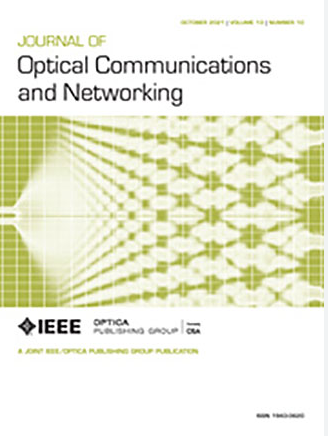Holographic viewpoint rotation prediction-based resource-efficient holographic-type communication service provision in an EON-enabled NG-RAN
IF 4.3
2区 计算机科学
Q1 COMPUTER SCIENCE, HARDWARE & ARCHITECTURE
引用次数: 0
Abstract
Holographic-type communication (HTC) services, driven by six degrees of freedom (6DoF)-enabled holographic viewpoints and multisensory media (e.g., visual, auditory, and olfactory) data, offer ultra-immersive realism but introduce significant challenges. Frequent and proactive user interactions in HTC exacerbate dynamic bandwidth demands and lead to redundant hologram transmissions, as users engage with only a small portion of the hologram at any time. Additionally, ultra-low latency and precise synchronization requirements across concurrent data flows carrying HTC services further complicate the resource-efficient multisensory data distribution. This paper investigates resource-efficient HTC service provision over an elastic optical network (EON)-enabled next-generation radio access network (NG-RAN), focusing on DU-CU deployment, holographic routing, and spectrum allocation for the transmission of holograms and multisensory media data. To address these issues, we propose a mixed-integer linear programming (MILP) model and a holographic viewpoint rotation prediction-based graph neural network with an edge-node switch convolution-enhanced deep reinforcement learning (VRP-GENSC-DRL) algorithm. The proposed algorithm integrates viewpoint rotation prediction (VRP) using long short-term memory (LSTM) to convert dynamic bandwidth demands into static requirements, a graph neural network (GNN) with edge-node switch convolution for precise feature extraction, and deep reinforcement learning (DRL) for optimized baseband function deployment and holographic RSA. Simulation results indicate that VRP-GENSC-DRL reduces the total number of active processing nodes and consumption of spectrum bandwidth by approximately 50% compared to benchmarks without VRP, effectively addressing the challenges of HTC service delivery.在EON-enabled NG-RAN中基于全息视点旋转预测的资源高效全息型通信服务提供
全息通信(HTC)服务由六自由度(6DoF)全息视点和多感官媒体(如视觉、听觉和嗅觉)数据驱动,提供超身临其境的真实感,但也带来了重大挑战。在HTC中,频繁和主动的用户交互加剧了动态带宽需求,并导致冗余的全息图传输,因为用户在任何时候都只参与全息图的一小部分。此外,承载HTC服务的并发数据流的超低延迟和精确同步要求进一步使资源高效的多感官数据分布复杂化。本文研究了基于弹性光网络(EON)的下一代无线接入网(NG-RAN)上资源高效的HTC服务提供,重点研究了用于传输全息图和多感官媒体数据的DU-CU部署、全息路由和频谱分配。为了解决这些问题,我们提出了一个混合整数线性规划(MILP)模型和一个基于全息视点旋转预测的图神经网络,该网络带有边缘节点交换卷积增强深度强化学习(VRP-GENSC-DRL)算法。该算法集成了利用长短期记忆(LSTM)的视点旋转预测(VRP)将动态带宽需求转化为静态带宽需求,利用边缘节点交换卷积的图神经网络(GNN)进行精确特征提取,利用深度强化学习(DRL)优化基带功能部署和全息RSA。仿真结果表明,与没有VRP的基准相比,VRP- gensc - drl减少了活跃处理节点总数和频谱带宽消耗约50%,有效地解决了HTC服务交付的挑战。
本文章由计算机程序翻译,如有差异,请以英文原文为准。
求助全文
约1分钟内获得全文
求助全文
来源期刊
CiteScore
9.40
自引率
16.00%
发文量
104
审稿时长
4 months
期刊介绍:
The scope of the Journal includes advances in the state-of-the-art of optical networking science, technology, and engineering. Both theoretical contributions (including new techniques, concepts, analyses, and economic studies) and practical contributions (including optical networking experiments, prototypes, and new applications) are encouraged. Subareas of interest include the architecture and design of optical networks, optical network survivability and security, software-defined optical networking, elastic optical networks, data and control plane advances, network management related innovation, and optical access networks. Enabling technologies and their applications are suitable topics only if the results are shown to directly impact optical networking beyond simple point-to-point networks.

 求助内容:
求助内容: 应助结果提醒方式:
应助结果提醒方式:


